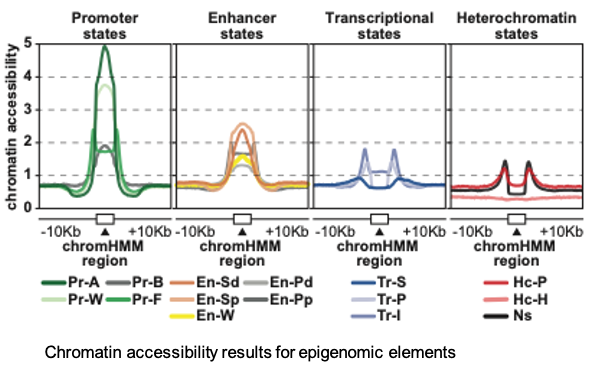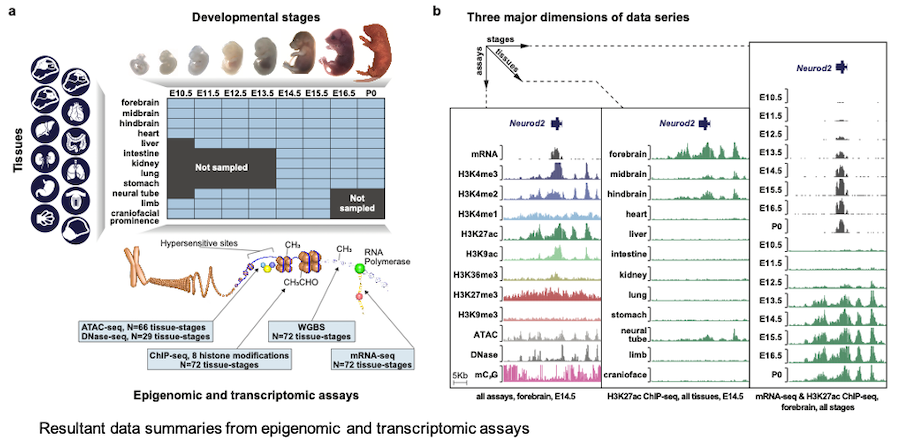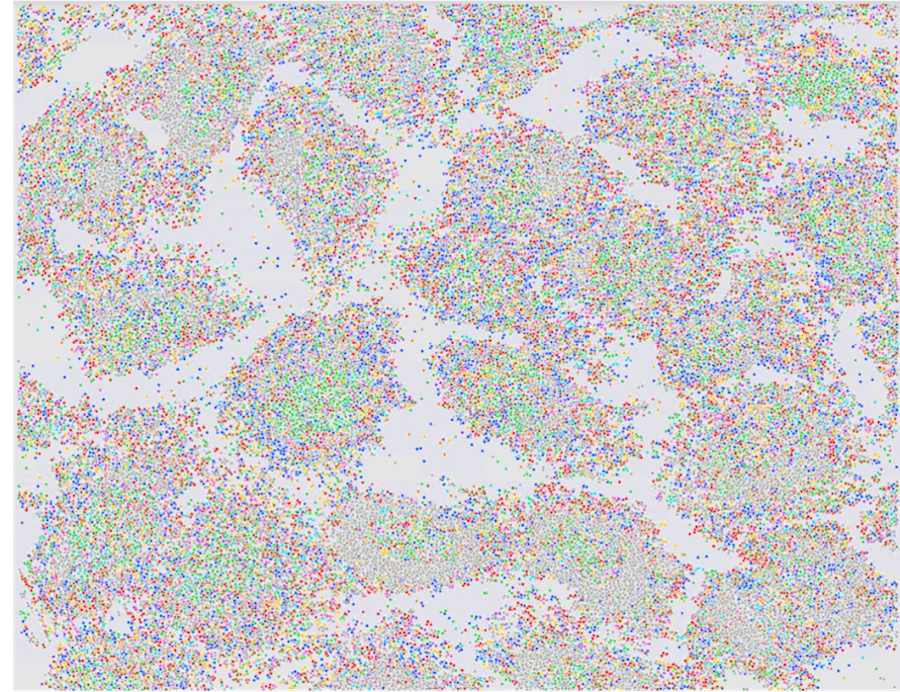Technologies

What is a genome?
A genome is more than just an abstract sequence of nucleotides — it is a collection of DNA molecules packaged inside of our cells. Epigenomic technologies allow us to look beyond the genome sequence, revealing information about how the genome actually exists in individual cells: bound by proteins, modified by enzymes, and folded inside the dynamic 3-dimensional space of the cell's nucleus. This epigenetic information is critical for understanding how each cell type in the human body functions during normal development, and how their function goes awry in disease.
Current research at the Center for Epigenomics focuses on exploring the function of multiple aspects of the epigenome in the context of human biology and disease — these aspects include chromatin accessibility, transcription factor binding, histone modification, and 3D chromatin architecture, in both bulk samples and in single cell resolution.
High-Throughput Epigenomics
The High-Throughput Epigenomics platform specializes in methods designed to study aspects of the epigenome, including chromatin accessibility, histone modifications, and 3-dimensional chromatin organization. By employing streamlined workflows, liquid handling robotics, and rigorous quality control, our team can achieve cutting-edge throughput and cost effectiveness. Below are descriptions of our most commonly used or latest methods:

- ATAC-SEQ -We use Assay for Transposase-Accessible Chromatin coupled with high-throughput sequencing ("ATAC-seq") to identify regions of the genome with regulatory activity. These regulatory regions are accessible to the binding of regulatory proteins that influence gene expression, and thus also accessible to the transposase enzyme used in ATAC-seq. We have developed a high-throughput version of ATAC-seq that is fully automated on liquid handling robots and can process up to 96 samples in parallel, and can work directly from a 96-well plate of cultured cells. Reference publications: PMID: 24097267, PMID:28846090.
- CHIP-SEQ - We use Chromatin Immunoprecipitation coupled with next-generation sequencing ("ChIP-seq") to measure how proteins bind to the genome. The genome is most closely associated with packaging proteins called histones, which can be post-translationally modified by enzymes in the cell. These histone modifications are core components of a cell's epigenome. They influence the activity of functional sequences in the genome and are maintained through cell division to pass on gene activity states from mother cell to daughter cells. Reference publication: PMID: 22763441.
- CUT&RUN / CUT&TAG - CUT&RUN and CUT&Tag are methods to map protein-DNA interactions which are quickly emerging as alternatives to ChIP-seq, which has traditionally been used for this purpose. Relative to ChIP, these methods offer a more streamlined workflow, require fewer cells, and often yield data with high signal-to-noise ratios. Reference publications: Cleavage Under Targets and Release Using Nuclease (CUT&RUN) -- PMID: 28079019, Cleavage Under Targets and Tagmentation (CUT&Tag) -- PMID: 31036827.
- HI-C - We use the chromatin conformation capture method "Hi-C" to map the 3-dimensionsal (3D) organization of chromatin inside the nucleus. 3D chroamtin organization is critical for genome function, and many features of 3D chromatin organization are known to influence gene regulation. Reference Publications: PMID: 19815776, PMID: 25497547.

Single Cell Epigenomics
The single cell epigenomics platform applies to technologies profiling single modalities like transcriptome using single cell RNA-seq, chromatin accessibility using single cell ATAC-seq and chromatin architecture using single cell HiC as well as joint profiling of chromatin accessibility and transcriptome from the same cell using Paired-seq. A major focus is to make these assays as widely applicable as possible by optimizing sample preparation for fresh and frozen tissues, cell lines and clinical biopsies. To this end the single cell epigenomics platform and its staff have established workflows to generate high-quality data for dozens of human tissues including brain, heart, lung, pancreas and cell types as well as workflows for evaluation of experimental conditions to generate high-quality data for novel sample types. Below are descriptions of our most commonly used or latest methods:

- SINGLE CELL ATAC-SEQ: To resolve cellular heterogeneity and delineate transcriptional regulatory sequences in the constituent cell types, we analyze the transposase-accessible chromatin in single-nuclei that have been isolated from tissue samples. We employ both an in-house, semi-automated robust platform using combinatorial barcoding (single cell indexing, sciATAC-seq) and the commercial droplet based single cell ATAC-seq approach from 10x Genomics with standard operating procedures. Depending on the sample type, research and budget we will work with collaborators to identify customized solutions and recommendations for each project.
- SINGLE CELL RNA-SEQ: To identify and characterize distinct cell types from heterogeneous biological samples (including frozen tissue biopsies), we use single cell and single nucleus RNA-seq. By combining flow cytometry with the 10x Genomics Chromium Platform, we can profile the RNA expression profile of thousands of cells or nuclei.
- PAIRED-SEQ: To profile transcriptome and chromatin accessibility jointly from the same cell or nucleus, we will use a semi-automated version of Paired-seq (parallel analysis of individual cell with RNA expression and DNA accessibility by sequencing) recently developed in the lab of our director Dr. Bing Ren. This highly scalable split-pool approach is currently under implementation at the Center.
- SINGLE CELL HI-C: To characterize chromatin architecture in single cells from cell lines and tissues we have implemented a semi-automated 96 well-based library preparation protocol.

Functional & Spatial Genomics
The Functional and Spatial Genomics Platform specializes in epigenomic technologies that functionally analyze both cis and trans elements of the mammalian genomes with a special focus on integrating spatial information obtained via high throughput sequencing and imaging approaches. Understanding how the epigenome drives phenotypes of cells in their morphological context is critical to understanding each cell's function, how cells work together, and what goes awry during disease and these technologies can guide you to that information. Below are descriptions of this platform's methods:
MERFISH
Multiplexed Error Robust Fluorescence In situ Hybridization (MERFISH) is an imaging method capable of simultaneously measuring the copy number and spatial distribution of hundreds to thousands of RNA species in single cells. The Center is working closely with the laboratory of Xiaowei Zhuang at Harvard to bring this transformative technology to San Diego researchers. Currently we are able to image the transcripts of 130 genes by precisely quantifying their copy numbers and registering their 3D localization in the context of their spatial niche.

Super-Resolution Chromatin Tracing
Proper organization of chromatin architecture has been increasingly recognized as a determining factor in regulating gene expression during normal cell cycle and development. Next generation sequencing-based technology, such as single nuclei Hi-C, has provided unprecedented information about chromatin architecture at single cell resolution. However, the application of this methodology has been limited by lack of spatial information, coupled with high-cost but low-throughput. A newly developed imaging technology has allowed for visualization of chromatin architecture with hybridization of multiplexed oligopaint probes. Such high-coverage oligopaint FISH has revealed higher order chromatin structure that are highly consistent with that from Hi-C experiments. With the two imaging systems, we are able to visualize individual chromatin 3D architecture up to 6 Mbp using sequential, multiplexed, high-throughput hybridization and imaging of oligopaint probes.
STARR-seq
Large scale sequencing efforts have identified and annotated candidate cis-elements of the genome, such as enhancers, that control cell type-specific gene expression. However, the functionality of the vast majority of these candidates remain largely unknown. Traditional methods of transgenic reporter or enhancer trap are laborious, costly and simply not feasible for large scale enhancer validation. Recent advances in massively parallel reporter assays (MPRAs) or STARR-seq, in which barcoded reporter libraries are introduced into cells and their transcripts can be quantified by RNA sequencing, enable high throughput assessment of candidate enhancers. However, STARR-seq experiments have been largely restricted to a limited set of cultured cells. To eliminate this application barrier, our platform will first adopt this technology at the Center and standardize the protocol. We will then adopt the plasmid-based reporter system into viral vector-mediated delivery approaches, with a focus on Adeno-Associated Virus (AAV) and lentiviral vectors.
